Overweight & Obesity Statistics
On this page:
- Defining Overweight and Obesity
- Prevalence of Overweight and Obesity
- Trends in Obesity among Adults and Youth in the United States
Defining Overweight and Obesity
A person whose weight is higher than what is considered to be a normal weight for a given height is described as being overweight or having obesity.1
Fast Facts
According to 2017–2018 data from the National Health and Nutrition Examination Survey (NHANES)
- Nearly 1 in 3 adults (30.7%) are overweight.2
- More than 2 in 5 adults (42.4%) have obesity.2
- About 1 in 11 adults (9.2%) have severe obesity.2
According to 2017–2018 NHANES data
- About 1 in 6 children and adolescents ages 2 to 19 (16.1%) are overweight.3
- Almost 1 in 5 children and adolescents ages 2 to 19 (19.3%) have obesity.3
- About 1 in 16 children and adolescents ages 2 to 19 (6.1%) have severe obesity.3
Using Body Mass Index (BMI) to Estimate Overweight and Obesity
BMI is a tool to estimate and screen for overweight and obesity in adults and children. BMI is defined as weight in kilograms divided by height in meters squared. BMI is related to the amount of fat in the body. A high amount of fat can raise the risk of many health problems. A health care professional can determine if a person’s health may be at risk because of his or her weight.
Adults
The table below shows BMI ranges for overweight and obesity in adults 20 and older.
BMI of Adults Ages 20 and Older
| BMI | Classification |
|---|---|
| 18.5 to 24.9 | Normal, or healthy, weight |
| 25 to 29.9 | Overweight |
| 30+ | Obesity (including severe obesity) |
| 40+ | Severe obesity |
Use this online tool from the Centers for Disease Control and Prevention (CDC) to gauge BMI for adults.
Children and Teens
A child’s body composition changes during growth from infancy into adulthood, and it differs by sex. Therefore, a young person’s weight status is calculated based on a comparison with other same-age and same-sex children or teens using CDC’s age- and sex-specific growth charts. The comparison results in a percentile placement. For example, a boy whose weight in relation to his height is greater than 75% of other same-aged boys places in the 75th percentile for BMI and is considered to be of normal or healthy weight.
Children grow at different rates at different times, so it is not always easy to tell if a child is overweight. A child’s health care professional should evaluate the child’s BMI, growth, and potential health risks due to excess body weight.
BMI for Children and Teens
| Weight Status Category | Percentile Range |
|---|---|
| Underweight | Less than 5th percentile |
| Normal or healthy weight | 5th percentile to less than 85th percentile |
| Overweight | 85th to less than 95th percentile |
| Obesity | 95th percentile or greater |
| Severe obesity | 120% of the 95th percentile |
Use this online tool from the CDC to calculate BMI and the corresponding BMI-for-age percentile based on CDC growth charts, for children and teens.
Causes and Health Consequences of Overweight and Obesity
Factors that may contribute to excess weight gain among adults and youth include genetics; types and amounts of food and drinks consumed; level of physical activity; degree of time spent on sedentary behaviors, such as watching TV, engaging with a computer, or talking and texting on the phone; sleep habits; medical conditions or medicines; and where and how people live, including their access to and ability to afford healthy foods and safe places to be active.4,5
Overweight and obesity increase the risk for many health problems, such as type 2 diabetes, high blood pressure, heart disease, stroke, joint problems, liver disease, gallstones, some types of cancer, and sleep and breathing problems, among other conditions.5,6 Learn more about the causes and health consequences of overweight and obesity.
Prevalence of Overweight and Obesity
Adults
Age-adjusted percentage of US adults with overweight, obesity, and severe obesity by sex, 2017–2018 NHANES Data2
| All (Men and Women) | Men | Women | |
|---|---|---|---|
| Overweight | 30.7 | 34.1 | 27.5 |
| Obesity (including severe obesity) | 42.4 | 43.0 | 41.9 |
| Severe obesity | 9.2 | 6.9 | 11.5 |
As shown in the above table
- Nearly 1 in 3 adults (30.7%) are overweight.
- More than 1 in 3 men (34.1%) and more than 1 in 4 women (27.5%) are overweight.
- More than 2 in 5 adults (42.4%) have obesity (including severe obesity).
- About 1 in 11 adults (9.2%) have severe obesity.
- The percentage of men who are overweight (34.1%) is higher than the percentage of women who are overweight (27.5%).
- The percentage of women who have severe obesity (11.5%) is higher than the percentage of men who have severe obesity (6.9%).
Age-adjusted prevalence of obesity among adults ages 20 and over, by sex and age: United States, 2017–20187
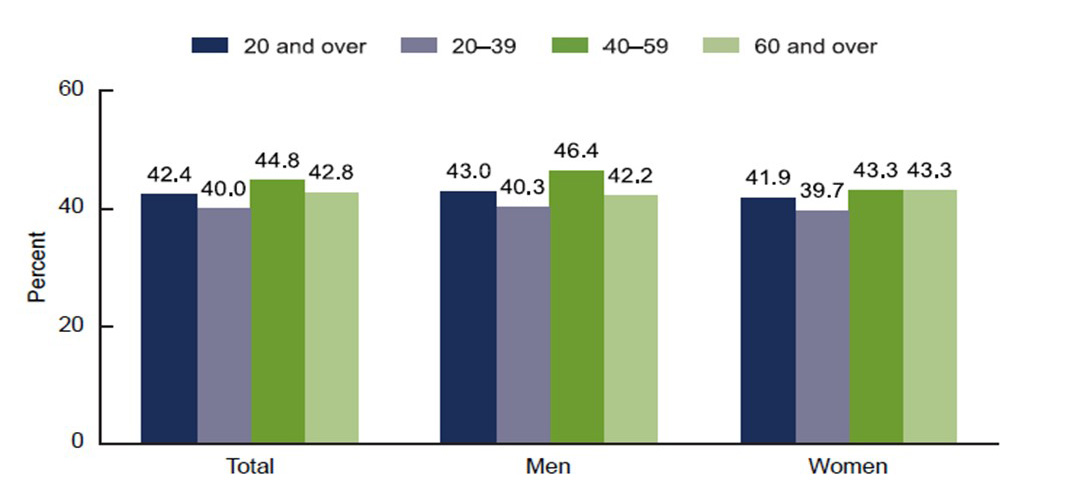 NOTES: Estimates for adults ages 20 and over were age adjusted by the direct method to the 2000 U.S. Census population using the age groups 20–39, 40–59, and 60 and over. Crude estimates are 42.5% for total, 43.0% for men, and 42.1% for women. Access data table for Figure 1 (PDF, 97.2 KB) .
NOTES: Estimates for adults ages 20 and over were age adjusted by the direct method to the 2000 U.S. Census population using the age groups 20–39, 40–59, and 60 and over. Crude estimates are 42.5% for total, 43.0% for men, and 42.1% for women. Access data table for Figure 1 (PDF, 97.2 KB) .SOURCE: National Center for Health Statistics, National Health and Nutrition Examination Survey, 2017–2018.
As shown in the above bar graph
- Among adults ages 20 and over, there are no significant differences in prevalence of obesity by sex or age group
Age-adjusted prevalence of obesity among adults ages 20 and over, by sex, race, and Hispanic origin: United States, 2017–20187
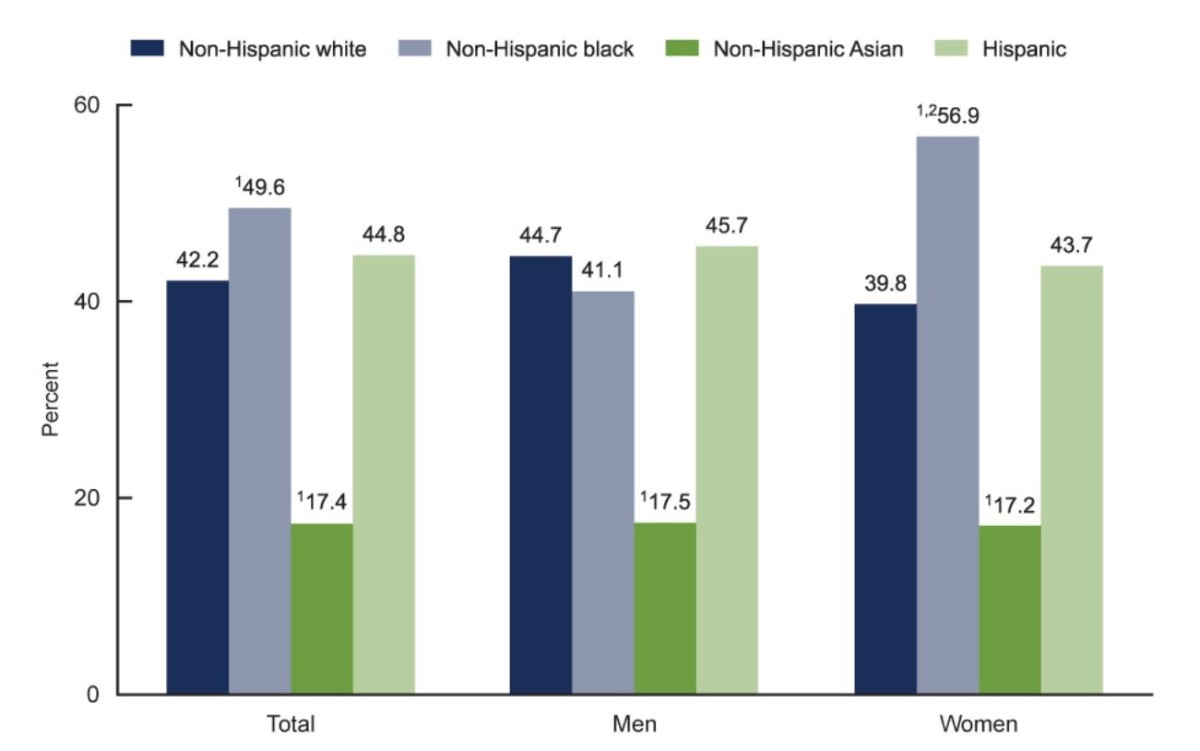 1Significantly different from all other race and Hispanic-origin groups.
1Significantly different from all other race and Hispanic-origin groups.2Significantly different from men for same race and Hispanic-origin group.
NOTES: Estimates were age adjusted by the direct method to the 2000 U.S. Census population using the age groups 20–39, 40–59, and 60 and over. Access data table for Figure 2 (PDF, 97.2 KB) .
SOURCE: National Center for Health Statistics, National Health and Nutrition Examination Survey, 2017–2018.
As shown in the above bar graph
- More than 2 in 5 non-Hispanic white adults (42.2%) have obesity.
- Nearly 1 in 2 non-Hispanic Black adults (49.6%) have obesity.
- More than 1 in 6 non-Hispanic Asian adults (17.4%) have obesity.
- Nearly 1 in 2 Hispanic adults (44.8%) have obesity.
- Obesity affects more than 2 in 5 non-Hispanic white men (44.7%), more than 2 in 5 non-Hispanic Black men (41.1%), more than 1 in 6 non-Hispanic Asian men (17.5%), and more than 2 in 5 Hispanic men (45.7%).
- Nearly 2 in 5 non-Hispanic white women (39.8%), more than half of non-Hispanic Black women (56.9%), more than 1 in 6 non-Hispanic Asian women (17.2%), and more than 2 in 5 Hispanic women (43.7%), have obesity.
Age-adjusted prevalence of severe obesity among adults ages 20 and over, by sex, age, and race and Hispanic origin: United States, 2017–20187
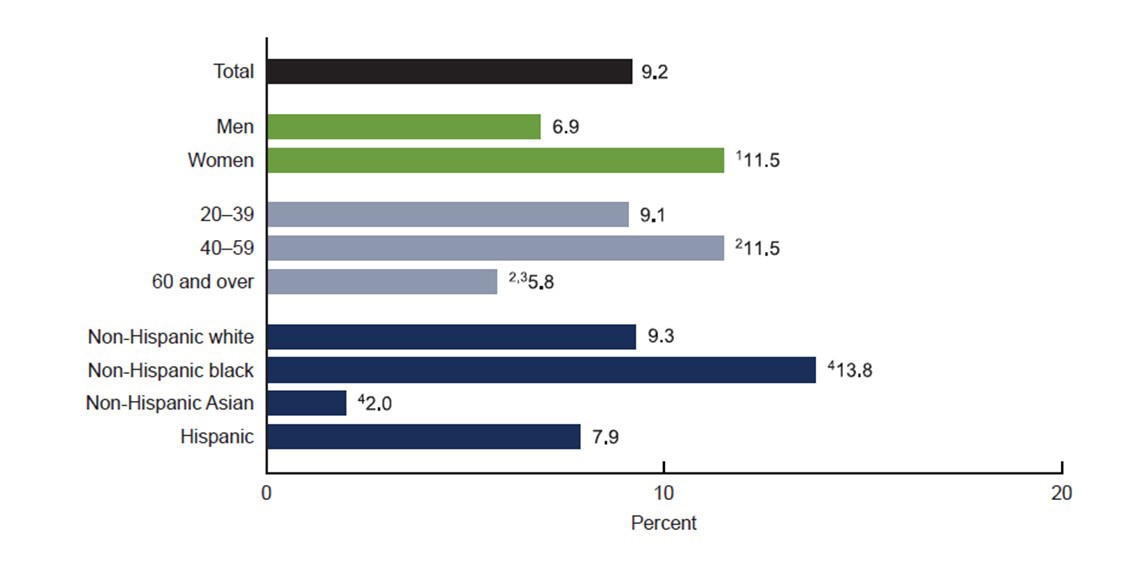 1Significantly different from men.
1Significantly different from men.2Significantly different from adults ages 20–39.
3Significantly different from adults ages 40–59.
4Significantly different from all other race and Hispanic-origin groups.
NOTES: Estimates for adults ages 20 and over were age adjusted by the direct method to the 2000 U.S. Census population using the age groups 20–39, 40–59, and 60 and over. Crude estimates are 9.0% for total, 6.8% for men, and 11.1% for women. Access data table for Figure 3 (PDF, 97.2 KB) .
SOURCE: National Center for Health Statistics, National Health and Nutrition Examination Survey, 2017–2018. As shown in the above bar graph, men and women differ in their rates of obesity and severe obesity.
- More women (11.5%) than men (6.9%) have severe obesity.
- Severe obesity was highest among people ages 40 to 59 (11.5%), followed by people ages 20 to 39 (9.1%) and people ages 60 and older (5.8%).
- About 1 in 11 non-Hispanic white adults (9.3%) have severe obesity.
- More than 1 in 8 non-Hispanic Black adults (13.8%) have severe obesity.
- About 1 in 50 non-Hispanic Asian adults (2.0%) have severe obesity.
- About 1 in 13 Hispanic adults (7.9%) have severe obesity.
- Severe obesity was highest among non-Hispanic Black adults (13.8%), followed by non-Hispanic white adults (9.3%), Hispanic adults (7.9%), and non-Hispanic Asian adults (2.0%).
Youth
Prevalence of overweight, obesity, and severe obesity among children and adolescents ages 2 to 19 years: United States, 2017–2018 NHANES data3
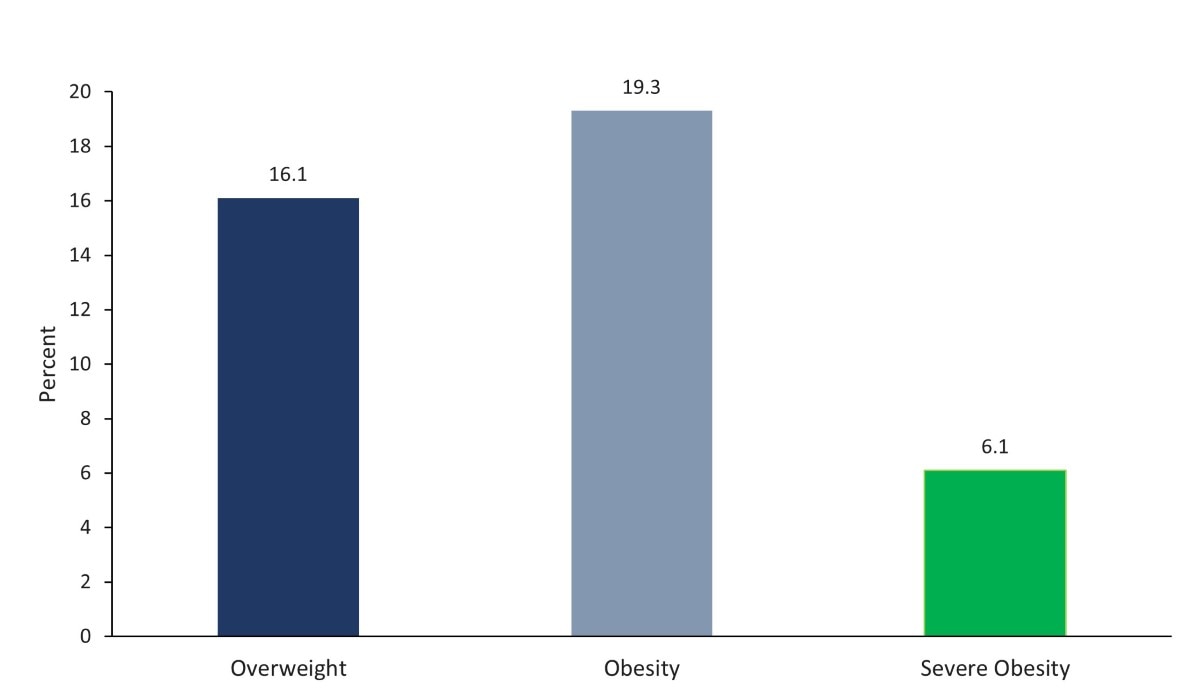 NOTE: Excludes pregnant females. Overweight is body mass index (BMI) at or above the 85th percentile and below the 95th percentile from the sex-specific BMI-for-age 2000 CDC Growth Charts. Obesity is BMI at or above the 95th percentile. Severe obesity is BMI at or above 120% of the 95th percentile.
NOTE: Excludes pregnant females. Overweight is body mass index (BMI) at or above the 85th percentile and below the 95th percentile from the sex-specific BMI-for-age 2000 CDC Growth Charts. Obesity is BMI at or above the 95th percentile. Severe obesity is BMI at or above 120% of the 95th percentile.SOURCE: National Center for Health Statistics, National Health and Nutrition Examination Survey.
Graphic representation created by the NIDDK. According to the 2017–2018 NHANES data
- Among children and adolescents ages 2 to 19, about 1 in 6 (16.1%) are overweight, more than 1 in 6 (19.3%) have obesity, and about 1 in 18 (6.1%) have severe obesity.
Prevalence of obesity among children and adolescents ages 2 to 19 years: United States, 2017–2018 NHANES data3
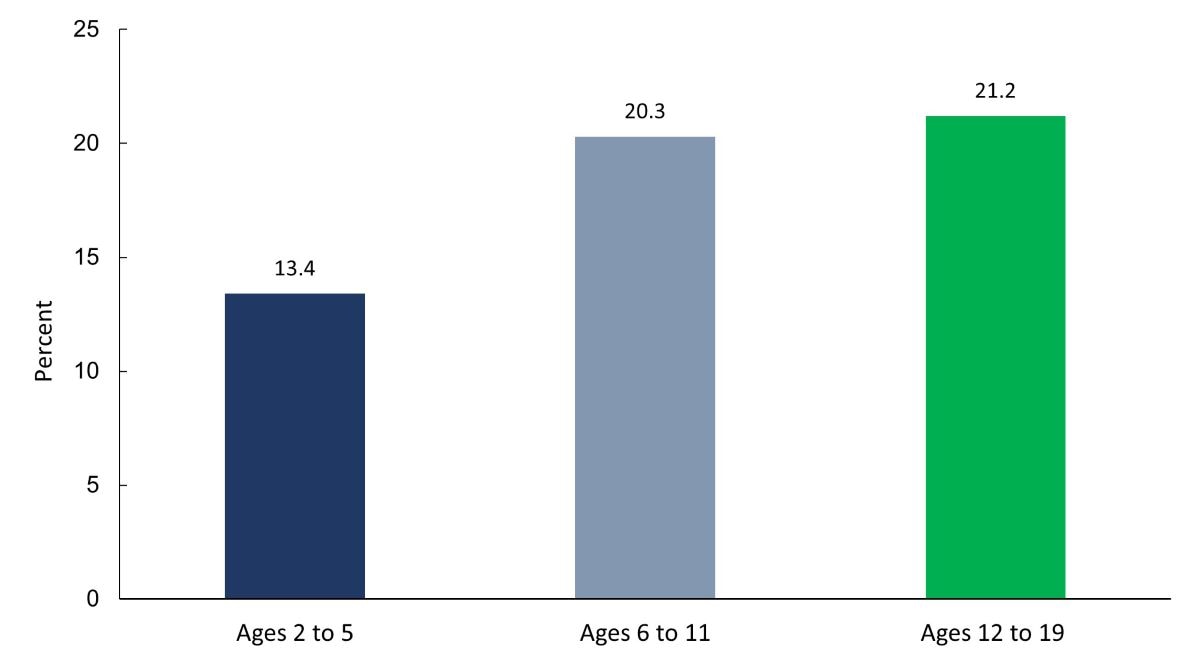 NOTE: Excludes pregnant females. Overweight is body mass index (BMI) at or above the 85th percentile and below the 95th percentile from the sex-specific BMI-for-age 2000 CDC Growth Charts.
NOTE: Excludes pregnant females. Overweight is body mass index (BMI) at or above the 85th percentile and below the 95th percentile from the sex-specific BMI-for-age 2000 CDC Growth Charts.SOURCE: National Center for Health Statistics, National Health and Nutrition Examination Survey.
Graphic representation created by the NIDDK. According to the 2017–2018 NHANES data
- Among children ages 2 to 5, more than 1 in 8 (13.4%) have obesity.
- Among children and youth ages 6 to 11, more than 1 in 5 (20.3%) have obesity.
- Among adolescents ages 12 to 19, more than 1 in 5 (21.2%) have obesity.
Prevalence of obesity among children and adolescents ages 2 to 19 years, by sex and race and Hispanic origin: United States, 2017–2018 NHANES data3
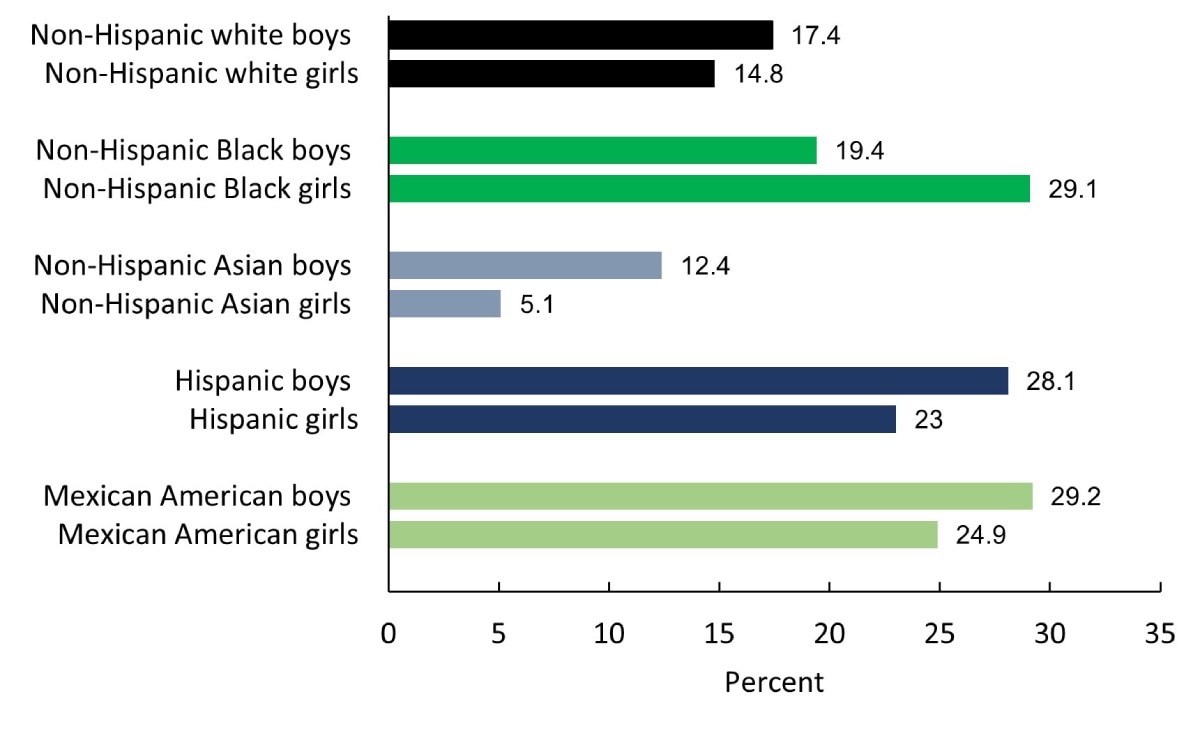 NOTE: Excludes pregnant females. Obesity is body mass index (BMI) at or above the 95th percentile from the sex-specific BMI-for-age 2000 CDC Growth Charts.
NOTE: Excludes pregnant females. Obesity is body mass index (BMI) at or above the 95th percentile from the sex-specific BMI-for-age 2000 CDC Growth Charts.* Estimate has a confidence interval width between 5 and 30 and a relative confidence interval width greater than 130%, and it does not meet National Center for Health Statistics (NCHS) standards of reliability; see Series Report 2, Number 175 (PDF, 1.6 MB) .
SOURCE: NCHS, National Health and Nutrition Examination Surveys, 1988–1994 and 1999–2018.
Graphic representation created by the NIDDK. According to the 2017–2018 NHANES data
- More than 1 in 6 non-Hispanic white boys (17.4%) have obesity and more than 1 in 7 non-Hispanic white girls (14.8%) have obesity.
- Nearly 1 in 5 non-Hispanic Black boys (19.4%) and more than 2 in 7 non-Hispanic Black girls (29.1%) have obesity.
- About 1 in 8 non-Hispanic Asian boys (12.4%) and about 1 in 20 non-Hispanic Asian girls (5.1%*) have obesity.
- About 2 in 7 Hispanic boys (28.1%) and nearly 1 in 4 Hispanic girls (23.0%) have obesity.
- More than 2 in 7 Mexican American boys (29.2%) and 1 in 4 of Mexican American girls (24.9%) have obesity.
* See asterisked note in the figure above.
Trends in Obesity among Adults and Youth in the United States
Adults
Trends in age-adjusted (PDF, 97.2 KB) obesity and severe obesity prevalence among adults ages 20 and over: United States, 1999–2000 through 2017–20187
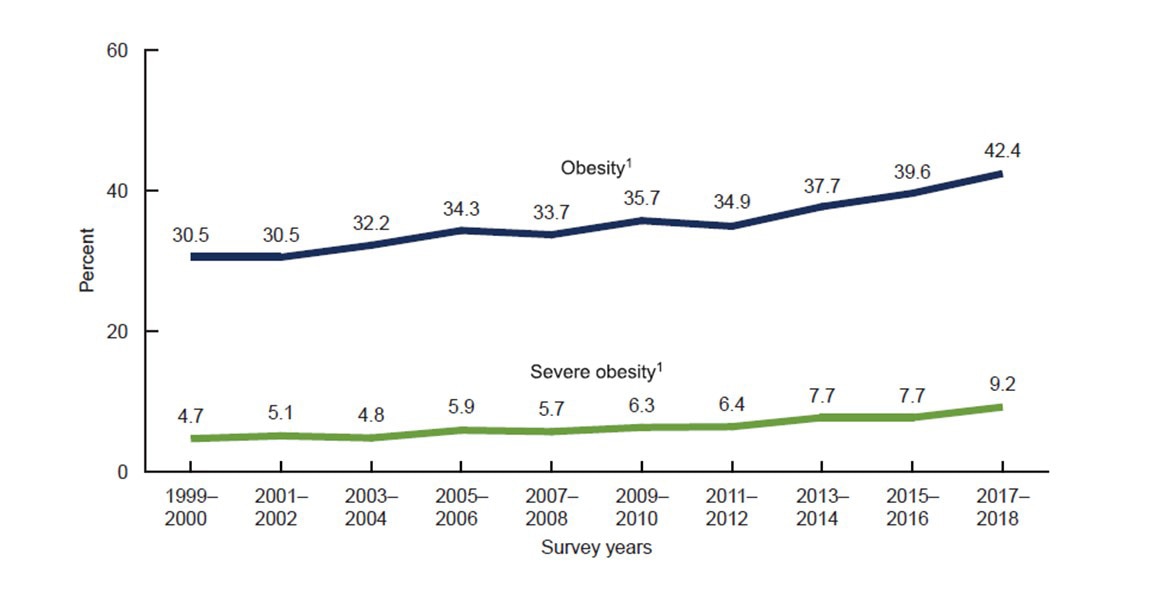 1Significant linear trend.
1Significant linear trend.NOTES: Estimates were age adjusted by the direct method to the 2000 U.S. Census population using the age groups 20–39, 40–59, and 60 and over. Access data table for Figure 4 (PDF, 97.2 KB) .
SOURCE: National Center for Health Statistics, National Health and Nutrition Examination Survey, 1999–2018. As shown in the figure above
- The prevalence of obesity and severe obesity increased significantly among adult men and women between 1999–2000 and 2017–2018.
Youth
Trends in obesity among children and adolescents ages 2–19 years, by age: United States, 1963–1965 through 2017–20183
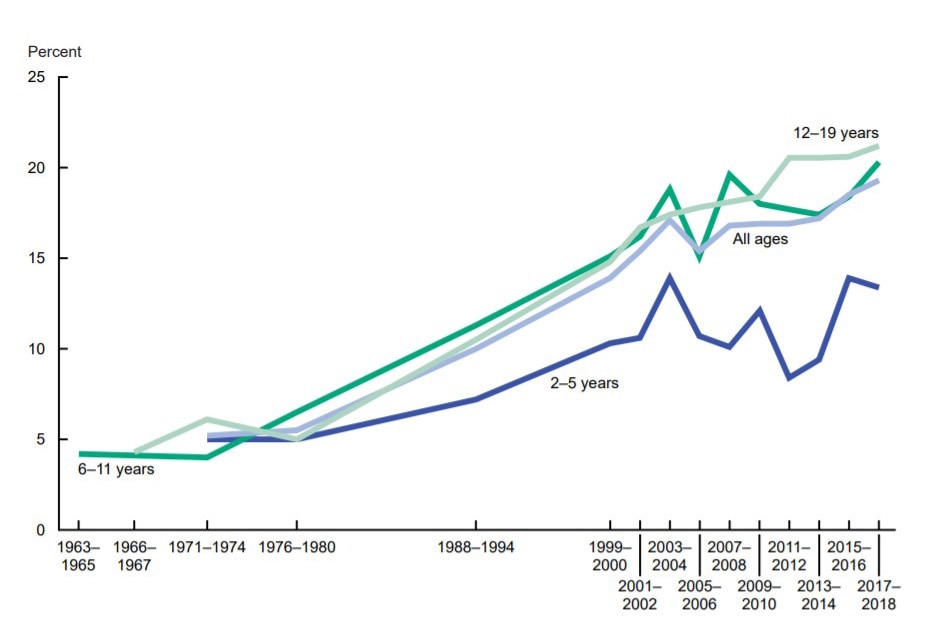 NOTE: Obesity is defined as body mass index (BMI) at or above the 95th percentile from the sex-specific BMI-for-age 2000 CDC Growth Charts.
NOTE: Obesity is defined as body mass index (BMI) at or above the 95th percentile from the sex-specific BMI-for-age 2000 CDC Growth Charts.SOURCES: National Center for Health Statistics, National Health Examination Surveys II (ages 6–11) and III (ages 12–17); and National Health and Nutrition Examination Surveys (NHANES) I–III, and NHANES 1999–2000, 2001–2002, 2003–2004, 2005–2006, 2007–2008, 2009–2010, 2011–2012, 2013–2014, 2015–2016, and 2017–2018.
As shown in the above line graph
- The prevalence of obesity among children and adolescents ages 2 to 19 years roughly doubled between 1988–1994 and 2017–2018.
- Among children ages 2 to 5, the prevalence of obesity increased between 1988–1994 and 2003–2004, decreased between 2003–2004 and 2011–2012, and then increased again.
- Among children ages 6 to 11, the prevalence of obesity increased between 1988–1994 and 2003–2004, fluctuated over the next several years, and most recently (2013–2014 to 2017–2018) increased.
- Among adolescents, ages 12 to 19, the prevalence of obesity has increased between 1988–1994 and 2017–2018.
References
This content is provided as a service of the National Institute of Diabetes and Digestive and Kidney Diseases
(NIDDK), part of the National Institutes of Health. NIDDK translates and disseminates research findings to increase knowledge and understanding about health and disease among patients, health professionals, and the public. Content produced by NIDDK is carefully reviewed by NIDDK scientists and other experts.
The NIDDK would like to thank:
Sohyun Park, Ph.D., Centers for Disease Control and Prevention, and Cheryl D. Fryar, M.S.P.H., National Center for Health Statistics, Centers for Disease Control and Prevention

